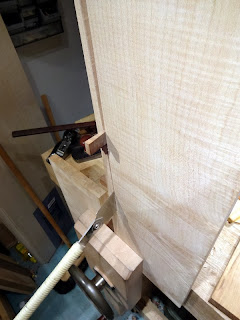OK, it IS taking forever.
Short version: I am working on a small box that I started years ago. It should be done soon.
Loooong:
Let me go through this from the beginning:
I need a couple of gifts coming up, and I thought it would be great to make something. It would be even better if I could actually finish these projects before they are late.
To help speed things up, why not pull out an old project that has been sitting unfinished? Why, what a great idea! I have just the thing.
Around the turn of the millenium, way back when I was hard core into machines and thought handtools were for weirdos, I discovered that you could buy lumber from eBay. Shipping was cheap in those days, and fancy exotics are available.
I got some nice little bits of claro walnut, figured maple, a pile of exotic offcuts, some cocobolo, and some stunning figured curly ebony. I thought it would be fun to make a bunch of humidors.
The ebony arrived, and was so gorgeous, I called the guy and ordered all of the ebony he had left. I wound up with six or seven nice one inch boards that are between three and six inches wide and about two feet long.
Those were expensive.
I figured I would get a plain piece of ebony, too. That way, I could practice up and when I got good enough, I would attempt something with that fancy ebony.
So there it still sits.
In the meantime, my career and my personal life made woodworking less practical, and here I am more than ten years later with a bunch of fancy, expensive scrap.
I guess that these are the last exotics I ever will purchase. It is too much like working concrete.
In the meantime, I have some gifts to get finished and in the mail. I chose to revisit two old projects:
 |
| A couple of very old projects. |
The top one is a small ebony box, the plain one. It looks like I started some dovetails, with the intention of cutting the box open once it is done to make a lid. Back in those days, I didn't know you could fit dovetails right from the saw, so there is a lot of fiddling before the one joint will fit. Then, I will have to dovetail the rest. No telling what this will look like when it is done, but it is started, I might as well finish it.
The bottom one is cocobolo, with mitered edges for a small box. It looks like I have a bottom fitted out of walnut. My guess is when I worked on it last I had some walnut that would work, and anything is better than the plywood that I originally intended. Hopefully I meant to try my hand at veneering, because cocobolo with plywood accents is just crazy.
There was only a groove in the bottom, and rather than mess with hinges, I decided to convert this project into a box with a sliding lid. Since the bottom is walnut, I picked a piece of walnut for the top, plowed a groove for it and glued everything up.
 |
| Glued up, with the lid fitted. |
I pre-finished the inside with Dick wax and a polissoir.
I was thrilled to be able to use my
rehabbed rabbet plane to cut the rabbets for the lid. I also used it to cut the chamfers. Using a fenceless rabbet plane really frees up time otherwise spent with fiddling with fences and depth stops. This lid was done in five minutes. I bet it would have taken me two hours doing it with a table saw.
I think that it needs a little more strength than glued miter joints, so I decided to use keys to strengthen things. I chose maple, thinking it might match the sapwood on the top near the lid. We'll see. To do these, I just cut diagonals using my biggest crosscut saw (for a wider kerf, and because cocobolo isn't any fun with a ripsaw), and inserted the keys.
Here is where we are with this project now:
 |
| Keys freshly glued. |
Hopefully tomorrow I can get the keys sawed flush and do some shaping to this box before the wax goes on.
I would love to find out I am not the only one who has unfinished projects older than 10 years hiding somewhere in the shop. Please let me know when you plan to finish yours.








































